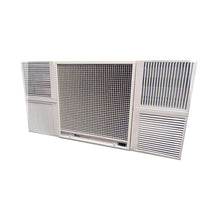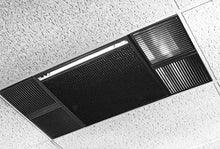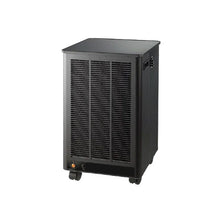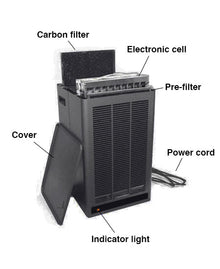Deconstructing the Costs: Total Ownership of a Commercial Smoke Air Purifier

The decision to invest in a commercial-grade air purification system, particularly a powerful smoke eater, is a sign of a smart, customer-focused business owner. You’ve recognized that superior indoor air quality (IAQ) is a major competitive advantage, driving customer dwell time, staff retention, and overall brand reputation.
But the purchase price of the unit is just the beginning of the conversation. Our years of experience bringing the best air purifiers to the market tell us that savvy business leaders are focused on the Total Cost of Ownership (TCO). They want to know the true, long-term cost, factoring in everything from electricity consumption to the necessary filter replacement cost for commercial air purifiers.
This comprehensive guide is designed to deconstruct the costs of a high-performance commercial smoke air purifier, moving past the sticker price to deliver transparent, actionable financial insight. We'll show you how the strategic investment in a quality smoke eater delivers ROI that far outweighs the cumulative air purifier operating expenses smoke over its lifespan.
The Hidden Cost of Poor Air Quality: Why TCO Matters
To truly appreciate the value of an air purification system, we must first quantify the alternative: the financial burden of poor indoor air quality. This is the invisible cost that quietly erodes your profits.
For businesses like cigar lounges, bars, and venues that permit smoking, the issue is immediate and severe. However, even in smoke-free environments, nearby pollutants, cooking fumes, and lingering odors can trigger customer discomfort and avoidance. Research consistently connects improved IAQ to economic benefits. A detailed review of scientific evidence confirms that investing in better IAQ can lead to higher productivity, reduced absenteeism, and increased job satisfaction among employees. While these studies often focus on office settings, the principles of comfort, health, and well-being translate directly to the customer experience in the hospitality and retail sectors.
Specifically in hotels, research has highlighted that a positive perception of air quality is a crucial factor influencing a guest's comfort, satisfaction, and, most importantly, their revisit intention. Customers are willing to pay more for environments that ensure their health and comfort. If a powerful commercial air purifier costs you a few dollars a day to run, but helps secure a returning, loyal, and higher-spending customer base, that investment is already paying for itself. Ignoring the need for clean air allows the hidden costs of reduced patronage, high staff turnover, and accelerated wear-and-tear on furnishings to accumulate—costs that invariably dwarf the long term cost of a smoke eater.
Component 1: Initial Investment (The Purchase Price)
The upfront cost of a commercial smoke air purifier, or commercial smoke eater, typically ranges from $1,200 to over $4,000 per unit, depending on the power, filtration stages, and installation type (e.g., portable, ceiling-mount, or ducted). As Commercial Air Purifiers, LLC, we recognize this is a substantial initial outlay, but it’s critical to understand what you are buying at this stage.
Why Commercial Units Cost More Than Residential
A commercial-grade unit is engineered to meet the demands of higher air volume and significantly heavier contaminant loads, like continuous tobacco smoke. They feature:
-
Higher Airflow (CFM): Commercial units must handle many more air changes per hour (ACH) to effectively clear a large space of dense smoke. A bar or lounge, for instance, may require 8 to 12 or more ACH for effective smoke removal, which mandates a higher CFM rating.
-
Durable Construction: Built for continuous 24/7 operation and industrial-grade environments, using materials and motors designed for longevity, not just light, intermittent use.
-
Deep Filtration Beds: The systems necessary to remove both the fine particles (aerosols) and the heavy gases/odors require large, multi-stage filter banks, which are inherently more expensive to manufacture and integrate.
When you look at the price tag, you are buying performance and durability that directly impacts the overall TCO by reducing the frequency of replacement and ensuring consistent, effective air cleaning.
Component 2: Operational Expenses (Electricity)
The air purifier operating expenses smoke includes the electrical power required to run the unit's powerful fan motor 24 hours a day. While powerful, these units are surprisingly efficient relative to the air volume they process.
The Wattage Benchmark
Commercial air purifiers, particularly those utilizing high-efficiency HEPA and deep-bed carbon filtration, generally consume 80 Watts (W) to 250W+ when running on medium to high speed. This range is comparable to a powerful desktop computer or a small refrigerator, not a massive energy drain like a central air conditioner.
To calculate your annual electricity cost, use this simple formula:
Assuming a commercial unit draws a maximum of and your local commercial electricity rate is :
As Commercial Air Purifiers, LLC, we emphasize that this cost is minimal when compared to the business benefit of providing a guaranteed clean-air environment. For just under a dollar a day per machine, you maintain a premium, comfortable space that encourages longer customer stays.
Component 3: Maintenance Costs (The Filters)
This is the most critical and variable factor in the commercial air purifier total cost equation. When dealing with heavy contaminants like smoke, filter media saturates much faster than in a clean office environment. A quality smoke eater requires a layered filter system, and you must budget for the continuous filter replacement cost commercial air purifier demands.
The Multi-Stage Filtration Reality
A reliable commercial smoke air purifier uses a sequence of filters, each with its own lifespan and cost:
-
Pre-Filter (The First Line of Defense): Captures large particles like dust and lint to protect the more expensive filters.
-
Cost: $30 - $100 (often washable or low-cost disposable).
-
Lifespan: Monthly to quarterly replacement, depending on smoke density.
-
-
HEPA Filter (Particle Removal): Captures the fine, solid aerosols found in smoke, which are responsible for respiratory irritation.
-
Cost: $150 - $800+ (depending on size and MERV rating, such as MERV 17).
-
Lifespan: 12 to 36 months in light-to-moderate smoke conditions; potentially shorter in heavy smoke.
-
-
Activated Carbon Filter (Odor & Gas Removal): This is the most crucial and most expensive filter for smoke. It uses pounds of activated carbon or specialized chemical media to adsorb the Volatile Organic Compounds (VOCs) and chemical gases that cause the lingering smoke smell.
-
Cost: $300 - $1,700+ (directly proportional to the weight and type of carbon/media).
-
Lifespan: 6 to 18 months in a smoke environment. When smoke is present, the carbon saturates quickly.
-
Real-World Filter Budgeting: Our Expert Insight
Based on our extensive experience and field testing, we can offer a realistic annual filter cost range for a high-traffic, moderate-smoke commercial environment:
-
Annual Filter Costs per Unit (Average): $400 to $850 per year.
This figure is what truly defines the long term cost of a smoke eater. To manage this cost effectively, we recommend:
-
Prioritize Carbon Weight: When comparing units, look for systems that use heavy, deep-bed activated carbon filters (15 lbs or more). While the replacement cost is higher, the extended lifespan of the heavier carbon often results in a lower cost-per-day, improving the long-term value.
-
Focus on Pre-Filter Maintenance: Diligently cleaning or replacing the inexpensive pre-filter as scheduled can significantly extend the life of the much more expensive HEPA and Carbon filters.
Component 4: Non-Financial Benefits and ROI
Calculating the Total Cost of Ownership is incomplete without factoring in the return on investment (ROI) derived from the enhanced customer and employee experience.
Health and Authority
By actively investing in a commercial smoke air purifier, you are demonstrating a commitment to health that aligns with authoritative guidelines. The World Health Organization (WHO) and the U.S. Environmental Protection Agency (EPA) both unequivocally state that there is no safe level of exposure to secondhand smoke (SHS). By implementing and visibly maintaining a high-performance smoke air purifier, you are acting as an industry expert, going above and beyond to mitigate this known risk, which builds immense trust with health-conscious patrons.
Experience Through Customer Feedback
In our hands-on work with businesses, the impact of installing effective smoke eaters is often immediate and measurable through customer feedback. Patrons don't just notice the absence of smoke; they comment on the freshness of the air. This shift transforms a formerly tolerable environment into a truly pleasant one, increasing customer dwell time and the resulting sales. A single customer who stays for one extra cocktail or purchases one additional item per visit because they are comfortable will often cover the unit's daily electrical cost.
Furthermore, a clean air environment drastically reduces staff complaints regarding air quality, contributing to lower turnover and reduced health-related costs—a substantial saving that offsets the commercial air purifier total cost.
Solutions: Finding the Right Balance for Your Budget
To achieve the best commercial air purifier total cost, you must match the unit's capability to your environment's needs.
-
For High-Density Smoke (e.g., Cigar Lounges): Your focus should be on Ceiling-Mount or Ducted Media-Filter Units with extremely high CFM ratings and the largest possible beds of activated carbon. The high initial cost is necessary, but the return is found in maintaining a premium, high-spend environment. Look for units that feature a Tar-Removal Pre-Filter to protect the main HEPA media from clogging due with sticky smoke residue.
-
For Moderate/Occasional Smoke (e.g., Vaping Areas, Designated Spaces): High-capacity Portable or Wall-Mounted Units with three-stage (Pre-Filter, HEPA, Carbon) filtration are often the most economical choice. These allow you to target purification resources precisely where they are needed, reducing the number of units and, consequently, the long-term air purifier operating expenses smoke.
The team at Commercial Air Purifiers, LLC is confident in stating that the smartest investment is choosing the unit with the highest effective CFM per dollar and the deepest carbon bed. This maximizes cleaning power while minimizing the long-term filter replacement cost commercial air purifier owners must bear.
Credible Conclusion: The Value of True Cost Transparency
The Total Cost of Ownership of a commercial smoke air purifier is more complex than a single price tag, involving the unit’s initial cost, minimal electrical draw, and the recurring expense of filter replacements. The long term cost smoke eater ownership is ultimately defined by the frequency and expense of replacing your carbon and HEPA filters.
However, viewing this as a pure expense misses the fundamental truth: this is an investment in revenue. For a few dollars a day in operating costs, you eliminate a significant business liability (poor air quality) and create a powerful competitive asset (a comfortable, clean-air environment). We recommend that you perform a simple cost-benefit analysis for your business: how many extra customer visits, or how much more money spent per customer, would it take to cover your annual TCO? The answer is usually far less than you think. Take the next step: consult with an air quality expert to model a solution for your space and lock in a predictable commercial air purifier total cost that secures your business’s future success.
FAQ: Common Questions on Commercial Smoke Air Purifier Costs
Q: Does running a commercial smoke eater 24/7 wear it out faster?
A: Commercial-grade units are designed for continuous duty (24/7) operation. The main component that "wears out" is the filter media, not the motor. Running a unit continuously is the only way to maintain consistent clean air and is a core part of its intended function.
Q: Can I save money by buying third-party, off-brand replacement filters?
A: We strongly caution against this. The performance of a smoke air purifier is entirely dependent on the quality and density of the filtration media. Off-brand filters often use less dense HEPA media, or, critically, less weight of activated carbon. This means they will need to be replaced far more often, leading to a much higher filter replacement cost commercial air purifier over time and, worse, a noticeable drop in air quality, negating your initial investment.
Q: What is the most significant maintenance cost for a commercial air purifier designed for smoke?
A: The activated carbon filter is almost always the highest recurring cost. Smoke is a gaseous pollutant, and only carbon can effectively adsorb the odor molecules. When carbon is saturated, the smoke smell returns, signaling a required—and costly—replacement. This is why paying for a system with a very deep carbon bed upfront pays off in the long run.
Q: Can I just use a higher MERV filter in my existing HVAC system to remove smoke?
A: While using a high-MERV filter (like a MERV 13 or 14) in your HVAC can help remove some smoke particles, it is generally insufficient for heavy smoke and odors. Firstly, your HVAC system may not be able to handle the restricted airflow of a high-MERV filter, potentially damaging the system. Secondly, most HVAC filters do not contain enough activated carbon media to effectively remove the strong, lingering odors of smoke. Dedicated smoke eater systems are the proven solution for targeted smoke removal.





